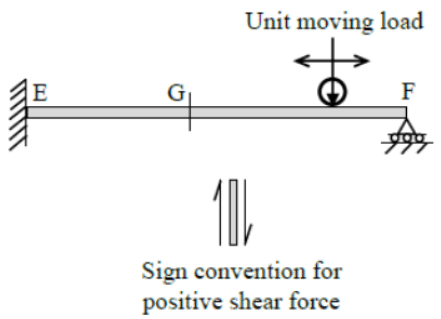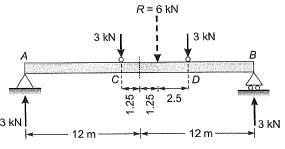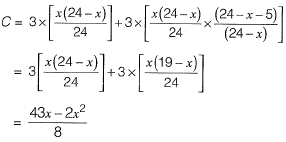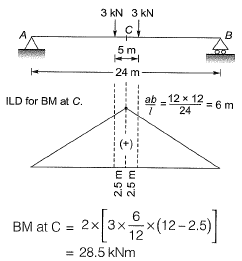Past Year Questions: Influence Line Diagram & Rolling Loads | Topic wise GATE Past Year Papers for Civil Engineering - Civil Engineering (CE) PDF Download
Q1: The horizontal beam PQRS shown in the figure has a fixed support at point P, an internal hinge at point Q, and a pin support at point R. A concentrated vertically downward load (V) of 10kN can act at any point over the entire length of the beam.
The maximum magnitude of the moment reaction (in kN.m ) that can act at the support P due to V is ______ (in integer). [2024, Set-2]
Ans: 150
Sol: Beam is determinate
ILD for BM at 'P' is given by Hence when point load is at 'Q' , the point of max ordinate for ILD for BM at P,BM at P will be max.
Hence when point load is at 'Q' , the point of max ordinate for ILD for BM at P,BM at P will be max.
⇒ Mp max = 10 x 15 = 150 kN - m
Q1: Muller-Breslau principle is used in analysis of structures for [2023, Set-2]
(a) drawing an influence line diagram for any force response in the structure
(b) writing the virtual work expression to get the equilibrium equation
(c) superposing the load effects to get the total force response in the structure
(d) relating the deflection between two points in a member with the curvature diagram in between
Ans: (a)
Sol: Muller Breslass principle is used to draw influence line diagram for determinate and indeterminate structures. It states that influence line for any stress function may be obtained by removing the restraint offered by that function and introducing a directly related generalised unit displacement at that location in the direction of the stress function.
Q1: Consider a simply supported beam PQ as shown in the figure. A truck having 100 kN on the front axle and 200 kN on the rear axle, moves from left to right. The spacing between the axles is 3 m. The maximum bending moment at point R is ______ kNm. (in integer) [2022, Set-1]
 Ans:180
Ans:180
Sol:



To get maximum BN at R
Q1: A propped cantilever beam EF is subjected to a unit moving load as shown in the figure (not to scale). The sign convention for positive shear force at the left and right sides of any section is also shown. [2021, Set-1]
 The CORRECT qualitative nature of the influence line diagram for shear force at G is
The CORRECT qualitative nature of the influence line diagram for shear force at G is
(a) 
(b)
(c)
(d)
Ans: (b)
Sol:
As per Muller Breslau principle ILD for stress function (shear−VG) will be a combination of curves (3∘ curves).
Q1: Distributed load(s) of 50 kN/m may occupy any position(s) (either continuously or in patches) on the girder PQRST as shown in the figure [2020, Set-1] The maximum negative (hogging) bending moment (in kNm) that occurs at point R, is
The maximum negative (hogging) bending moment (in kNm) that occurs at point R, is
(a) 22.5
(b) 56.25
(c) 93.75
(d) 150
Ans: (b)
Sol: ILD for BM at R:
ILD for BM at R:
To get maximum hogging BM at R, keep UDL over PQ and ST.
= 56.25 kNm
Q1: A long uniformly distributed load of 10 kN/m and a concentrated load of 60 kN are moving together on the beam ABCD shows in the figure (not drawn to scale). The relative positions of the two loads are not fixed. The maximum shear force (in kN, round off to the nearest integer) caused at the internal hinge B due to the two loads is______ [2019, Set-2]
Ans: 70
Sol: ILD for VB


Q2: Consider the beam ABCD shown in the figure
For a moving concentrated load of 50 kN on the beam, the magnitude of the maximum bending moment (in kN-m) obtained at the support C will be equal to _________ . [2017 : 2 Marks, Set-I]
Solution:

ILD for BM at C

Max. BM occurs at C, when 50 kN load is at B.
Max. BM at C = 50 x (-4) = -200 kNm
Q.3 A simply supported beam AB of span, L = 24 m is subjected to two wheel loads acting at a distance, d = 5 m apart as shown in the figure below. Each wheel transmits a load, P = 3 kN and may occupy any position along the beam. If the beam is an I-section having section modulus, S=16.2 cm3, the maximum bending stress (in GPa) due to the wheel loads is _________ . [2015 : 2 Marks, Set-II]
Solution:
Method-1 (By ILD)
C.G. of system = 2.5 m from any load
For maximum bending moment, system of load should be,


Maximum BM will occur below load at C. Ordinate of ILD at C
Ordinate of ILD at D
Maximum BM = 5.935 x 3 + 3.695 x 3
= 28.89 kN-m
Maximum bending stress,
Method-II (By Statics)
Let the section at which absolute max. BM ocurs be at x distance from left support.
Max. BM at section
For absolute max. BM,
⇒ 
⇒ x = 10.75 m
Absolute max BM
Absolute max bending stress
AVOID MISTAK
(I)
Max. bending stress
(II)


Max. bending stress
This is the maximum bending stress at mid= span and not the absolute max. bending stress in the beam.
Q.4 In a beam of length L, four possible influence line diagrams for shear force at a section located at a distance of L/4 from the left end support (marked as P, Q, R and S) are shown below. The correct influence line diagram is [2014 : 1 Mark, Set-I]



(a) P
(b) Q
(c) R
(d) S
Ans. (A)
Solution:

Q.5 Beam PQRS has internal hinges in spans in spans PQ and RS as shown. The beam may be subjected to a moving distributed vertical load of maximum intensity 4 kN/m of any length anywhere on the beam. The maximum absolute value of the shear force (in kN) that can occur due to this loading just to the right of support Q shall be [2013 : 2 Marks]
(a) 30 kN
(b) 40 kN
(c) 45 kN
(d) 55 kN
Ans. (C)
Solution:
Drawing the ILD of shear force just to right of Q by using Muller Breslau’s principle. A cut is made just to the right of Q, since cut is very close to support Q, therefore displacement of left portion is almost zero and that to the right portion will be 1.
If moving distributed load is present over span PR then we get maximum shear force just to the right of Q.
FAQs on Past Year Questions: Influence Line Diagram & Rolling Loads - Topic wise GATE Past Year Papers for Civil Engineering - Civil Engineering (CE)
| 1. What is an influence line diagram in civil engineering? |  |
| 2. How is an influence line diagram constructed? |  |
| 3. What are the applications of influence line diagrams in civil engineering? |  |
| 4. How are rolling loads considered in influence line diagrams? |  |
| 5. Can influence line diagrams be used for structures other than beams and bridges? |  |
















